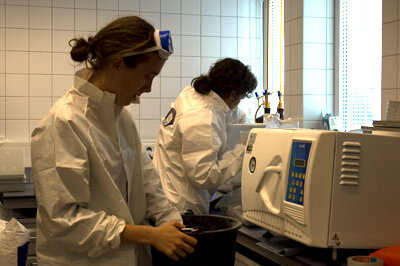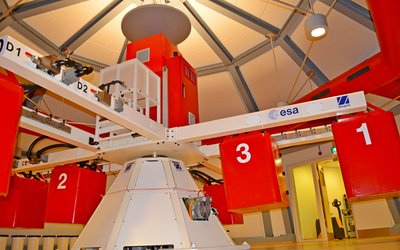Meet the teams: Impact
Four teams of university students were selected to develop and perform their hypergravity experiments during ESA’s ‘Spin your Thesis!’ 2010 campaign. Here is an introduction to the team from Scotland, UK.
![]()
![]()
The Physical and Dynamical Investigation of Large Scale Impact Cratering Events on Highly Porous Asteroidal Bodies
![]()
![]()
| University | University of Glasgow, Scotland, UK |
| Endorsing professor |
Dr Massimiliano Vasile Aerospace Engineering, University of Glasgow Scotland, UK |
| ELGRA mentor |
Prof. dr. Willy Benz Physikalisches Institut, Universität Bern, Switzerland |
| Team | Alison Gibbings, Kyle Borland, Eirini Komninou, Rachel Anne Page |

Team Impact was composed of four students from the University of Glasgow, Scotland, United Kingdom. Their experiment intended to reproduce, investigate and define the physical conditions of large scale, low velocity impact cratering events on highly porous asteroids and other small bodies.
Using the principle of similarity analysis, a small scale centrifugal cratering event becomes a geometric and physical replica of an asteroid’s much larger in-situ cratering event, ensuring that the same lithostatic stress, shear stresses and ejecta profiles occur. Under these conditions, the overriding influence of the target material’s composition, the projectile’s density and impact geometry (e.g. highly oblique impact angles) as a function of the crater’s morphological profile and ejecta distribution are exclusively addressed. This includes multiple and singular cratering events. Therefore, large size, low velocity analogue cratering experiments provide scientists with a detailed insight into a range of mechanical processes that has yet to be quantified; offering a new enlightened understanding into the theory of the cratering phenomenon.

The student experiment was comprised of four main elements, including; the test chamber, the target material, the projectiles and the projectiles release mechanism. In order to assess kilometre size impact events onto highly porous asteroidal bodies, a series of repeatable cratering events under elevated acceleration condition (20 times Earth’s gravity maximum) were conducted. During each test, independent variations in the projectile’s density and impact geometry (highly oblique angles, changes in the surface curvature) were assessed. This occured for cratering events under the conditions of high porosity, for both multiple and singular cratering events. Calibration before the test campaign begins ensured that only the desirable impact velocities and variation in impact angle were achieved.
The data collected from this experiment can provide impact and crater response data for the validation and advancement of numerical models and scaling theory, thereby supporting the mission capabilities of ongoing activities, and the design requirement for any future asteroid impactors, sample return activity and/or mitigation studies.
Read the final experiment report here.






